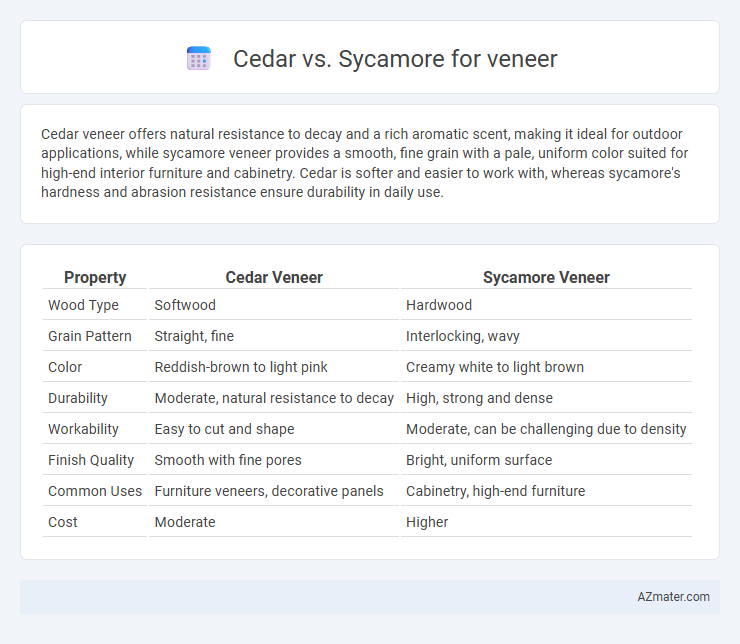Cedar veneer offers natural resistance to decay and a rich aromatic scent, making it ideal for outdoor applications, while sycamore veneer provides a smooth, fine grain with a pale, uniform color suited for high-end interior furniture and cabinetry. Cedar is softer and easier to work with, whereas sycamore's hardness and abrasion resistance ensure durability in daily use.
Table of Comparison
| Property | Cedar Veneer | Sycamore Veneer |
|---|---|---|
| Wood Type | Softwood | Hardwood |
| Grain Pattern | Straight, fine | Interlocking, wavy |
| Color | Reddish-brown to light pink | Creamy white to light brown |
| Durability | Moderate, natural resistance to decay | High, strong and dense |
| Workability | Easy to cut and shape | Moderate, can be challenging due to density |
| Finish Quality | Smooth with fine pores | Bright, uniform surface |
| Common Uses | Furniture veneers, decorative panels | Cabinetry, high-end furniture |
| Cost | Moderate | Higher |
Introduction to Cedar and Sycamore Veneer
Cedar veneer, known for its rich reddish-brown hues and natural resistance to decay and insects, offers a warm, aromatic finish ideal for cabinetry and decorative paneling. Sycamore veneer features a lighter, creamy color with distinctive, subtle grain patterns that provide a smooth and elegant surface, favored for fine furniture and interior trim. Both veneers bring unique aesthetic qualities and durability, making them popular choices in woodworking and interior design applications.
Botanical Overview: Cedar vs Sycamore
Cedar (genus Cedrus) is an evergreen conifer known for its aromatic wood and durable, resinous properties, making it resistant to decay and insects, widely used in veneer applications. Sycamore (genus Platanus), a deciduous hardwood, features a pale, smooth grain with interlocking fibers that create distinctive patterns, often chosen for decorative veneer work due to its aesthetic appeal. Both species offer unique botanical characteristics influencing veneer quality: Cedar's softwood density provides stability and scent, while Sycamore's hardwood complexity enhances visual texture and finish.
Appearance and Grain Patterns
Cedar veneer showcases a rich, reddish-brown hue with a straight, uniform grain pattern that offers a warm, rustic appearance ideal for traditional and cabin-style interiors. Sycamore veneer features a lighter, creamy color with a distinctive, interlocking grain that creates a subtle figure and a smooth, elegant surface, enhancing modern and contemporary designs. The contrast between cedar's deep tones and sycamore's brightness allows for varied aesthetic applications depending on the desired visual impact and design style.
Workability and Ease of Application
Cedar veneer offers superior workability due to its lightweight and fine grain structure, making it easy to cut, sand, and shape without splintering. Sycamore veneer, while denser and harder, demands more precision and sharper tools to avoid chipping during application, but provides a smoother, more polished finish when properly handled. Both veneers benefit from careful moisture control and adhesive selection to ensure strong bonding and long-lasting results.
Durability and Longevity
Cedar veneer offers moderate durability with natural resistance to decay and insect damage, making it suitable for indoor applications where longevity is desired but exposure to harsh conditions is limited. Sycamore veneer, while less resistant to moisture and pests, provides greater strength and wear resistance, resulting in enhanced longevity in environments requiring more robust surface durability. Choosing between cedar and sycamore veneers depends on balancing the need for natural decay resistance against the demand for mechanical strength and durability in the intended application.
Color Retention and Aging
Cedar veneer maintains its rich reddish-brown hues longer due to natural oils that resist fading and discoloration over time. Sycamore veneer, with its lighter, creamy tones, tends to yellow and darken more noticeably as it ages, especially under prolonged exposure to sunlight. Choosing cedar ensures superior color retention and a stable appearance for veneered surfaces in aging applications.
Cost Comparison: Cedar vs Sycamore Veneer
Cedar veneer typically costs less than sycamore due to its wider availability and faster growth rate, making it a budget-friendly option for furniture and paneling. Sycamore veneer, known for its distinct grain patterns and lighter color, commands higher prices as a premium hardwood choice. The price difference can vary by region but generally, sycamore is 20-40% more expensive than cedar veneer.
Environmental Impact and Sustainability
Cedar veneer is often preferred for its natural resistance to decay, reducing the need for chemical treatments and enhancing sustainability through durability. Sycamore veneer, sourced primarily from fast-growing deciduous trees, supports reforestation efforts and carbon sequestration, making it an eco-friendly option. Both materials, when harvested responsibly from certified forests, contribute to reduced environmental impact by promoting sustainable forestry practices.
Ideal Applications for Each Wood
Cedar veneer excels in applications requiring natural resistance to moisture and decay, making it ideal for exterior paneling, marine environments, and sauna interiors. Sycamore veneer, with its fine, uniform texture and pale coloration, is preferred for indoor furniture, cabinetry, and decorative wall panels where a smooth, elegant finish is desired. Both woods offer distinct aesthetic and functional advantages suited to specific design requirements and environmental conditions.
Final Verdict: Choosing Between Cedar and Sycamore for Veneer
Cedar veneer offers excellent durability, natural resistance to moisture, and a warm reddish hue ideal for rustic or traditional designs, while sycamore veneer provides a fine, uniform grain with a light, creamy color perfect for modern and minimalist aesthetics. The choice hinges on the desired visual impact and environmental conditions, with cedar excelling in outdoor or high-humidity settings and sycamore preferred for indoor applications requiring a smooth, elegant finish. For long-lasting, moisture-resistant projects, cedar is optimal; for refined, contemporary interiors, sycamore remains the superior option.

Infographic: Cedar vs Sycamore for Veneer
 azmater.com
azmater.com